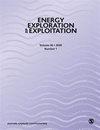牛至叶(Plectranthus amboinicus,Lour)的太阳能干燥:热带气候下的实验性能分析
IF 1.6
4区 工程技术
Q4 ENERGY & FUELS
引用次数: 0
摘要
牛至(Plectranthus amboinicus (Lour))是一种重要的草本植物,因其具有药用和烹饪特性而被广泛应用,尽管如此,有关该物种太阳能干燥的研究却十分有限。因此,在这项研究工作中,利用直接和间接太阳能干燥以及电烤箱对热带气候下的牛至叶进行了实验性干燥。此外,还对干燥过程、水分扩散、活化能和比色分析(作为质量参数)进行了数学建模,以补充实验评估并了解干燥过程的行为。结果表明,电烘箱的干燥时间较短,在 65°C 温度下可达到 210 分钟;然而,间接太阳能干燥器的最大干燥速率为每分钟 0.025 克水/克干物质时,太阳能干燥时间(250 分钟)最短,最终水分在 0.28 至 0.13 克水/克干物质之间。此外,更能代表实验数据的模型是修正佩奇模型、佩奇模型和对数模型,其中对数模型的 R2 最大值为 0.9980。此外,太阳能直接干燥器自然对流的最大有效扩散值为 1.81E-9,而电烤箱在 45、55 和 65°C 温度下的最大有效扩散值分别为 1.14E-10、2.280E-10 和 1.026E-09。太阳能干燥器和电烤箱中牛至叶片水分扩散的活化能分别为 55.66 和 97.78 kJ/g mol,与文献报道的数值非常接近。最后,比色分析表明,间接太阳能干燥器的最小变色值为 17.1,可以更好地保存牛至并保持其在市场上的质量,这使其成为热带气候条件下干燥牛至的理想选择,并促进了太阳能干燥的使用,促进了该地区的可持续发展。本文章由计算机程序翻译,如有差异,请以英文原文为准。
Solar drying of oregano leaves (Plectranthus amboinicus, Lour): Analysis of experimental performance under a tropical climate
Despite the multiple applications of the oregano ( Plectranthus amboinicus (Lour)), an important herbaceous plant because of its medicinal and culinary properties, limited research has been conducted on this species’ solar drying. Thus, the experimental drying of oregano leaves in a tropical climate was performed using direct and indirect solar drying and an electric oven in this research work. Also, mathematical modeling of the drying process, moisture diffusivity, activation energy, and colorimetric analysis (as a quality parameter) were accomplished to complement the experimental evaluation and understand the drying process behavior. The results show a shorter drying time obtained with the electric oven with 210 min reached at 65°C; however, the minimum solar drying time (250 min) was achieved with a maximum drying rate of 0.025 g water/g dry matter per minute and minimum final moisture between 0.28 and 0.13 g water/g dry matter was obtained with indirect solar dryer. Moreover, the models that better represented the experimental data were Modified Page, Page, and Logarithmic, with a maximum value of R2 obtained of 0.9980 corresponding to the Logarithmic model. Furthermore, a maximum effective diffusivity value of 1.81E-9 was obtained with direct solar dryer natural convection, while for the electric oven, were 1.14E-10, 2.280E-10, and 1.026E-09 for 45, 55, and 65°C, respectively. The activation energy for water diffusion in oregano leaves was 55.66 and 97.78 kJ/g mol for solar dryers and electric ovens, respectively, which were values very close to those reported in the literature. Finally, the colorimetric analysis exhibited a minimum color change value of 17.1 obtained for the indirect solar dryer, allowing better oregano preservation and maintaining its quality for the market, which makes it ideal for drying oregano in tropical climates and promotes solar drying use for sustainable growth of the region.
求助全文
通过发布文献求助,成功后即可免费获取论文全文。
去求助
来源期刊

Energy Exploration & Exploitation
工程技术-能源与燃料
CiteScore
5.40
自引率
3.70%
发文量
78
审稿时长
3.9 months
期刊介绍:
Energy Exploration & Exploitation is a peer-reviewed, open access journal that provides up-to-date, informative reviews and original articles on important issues in the exploration, exploitation, use and economics of the world’s energy resources.
 求助内容:
求助内容: 应助结果提醒方式:
应助结果提醒方式:


